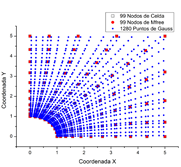Solving the Kirsch Problem with Mesh-free Elements Using Radial Base Interpolation Functions
Main Article Content
Keywords
Mfree, Mfree (Elementos Libres de Malla), Mesh-free elements, RPIM (Método de interpolación de puntos radiales), RPIM, MQ (Multi-cuadráticas)., Radial Point Interpolation Method, RBF, Radio Basis Functions Multi-quadratics
Abstract
The problem of Kirsch published in 1898, is used as a basis for corroborating the relative precision of numerical methods developed in the mechanics of solids. For this reason, the solution of this problem is used to evaluate the accuracy of the Mfree numerical method with a function of form using the radial points of interpolation, in the mesh-free numerical method. The radial points of interpolation method (RPIM) is an interpolation technique used to construct form functions with locally distributed nodes in a weak formulation that allows the representation of the problem as a system of equations. The most common type of functions are the polynomial functions or MQ radial basis functions (RBF), which was used for the stability it presents at the moment of solving the problem numerically. The most common type of functions are the polynomial functions or radial basis functions (RBF), which was used for the stability it presents at the moment of solving the problem numerically. To make the comparison we used the analytical solution given by Kirsch and the numerical solution developed in the present work, obtained an error of 0.00899%, which shows that the Mfree technique with radial bases of interpolation MQ are accurate and reliable when used as a numerical method of analysis.
Downloads
References
[2] W. P. Jones, R. A. Frazer and S. W. Skan, “Approximations to functions and to the solutions of differential equations,” Britain Aerospace Research Council London. Report and Memo No. 1799. Reprinted in Great Britain Air Ministry Aerospace Research Communication Technical Report, 1, 735, Tech. Rep., 1937.
[3] C. Lanczos, “Trigonometric Interpolation of Empirical and Analytical Functions,” Journal of Mathematics and Physics, vol. 17, no. 1-4, pp. 123– 199, 1938. [Online]. Available: http://dx.doi.org/10.1002/sapm1938171123
[4] A. J. Chorin, “Numerical study of slightly viscous flow,” Journal of Fluid Mechanics, vol. 57, no. 4, pp. 785–796, 1973.
[5] P. S. Bernard, “A Deterministic Vortex Sheet Method for Boundary Layer Flow,” Journal of Computational Physics, vol. 117, no. 1, pp. 132–145, 1995. [Online]. Available: http://www.sciencedirect.com/science/article/pii/ S0021999185710510
[6] V. Girault, “Theory of a finite difference method on irregular networks,” SIAM Journal on Numerical Analysis, vol. 11, no. 2, pp. 260–282, 1974. [Online]. Available: https://doi.org/10.1137/0711026
[7] V. Pavlin and N. Perrone, “Finite difference energy techniques for arbitrary meshes applied to linear plate problems,” International Journal for Numerical Methods in Engineering, vol. 14, no. 5, pp. 647–664, 1979. [Online]. Available: http://dx.doi.org/10.1002/nme.1620140503
[8] D. Vesey, C. Snell and P. Mullord, “The application of a general ffdm to some boundary value problems,” Composite Structures, no. 13, pp. 547–552, 1981.
[9] T.LiszkaandJ.Orkisz,Finite difference method at arbitrary irregular meshes in non-linear problems of applied mechanics. Structuralmechanicsinreactor technology, 1977, vol. 10, no. 12.
[10] J. Krok and J. Orkisz, A Unified Approach to the FE and Generalized Variational FD Methods in Nonlinear Mechanics, Concepts and Numerical Approach. Berlin, Heidelberg: Springer Berlin Heidelberg, 1990, pp. 353–362. [Online]. Available: https://doi.org/10.1007/978-3-642-49373-7_33
[11] L. B. Lucy, “A numerical approach to the testing of the fission hypothesis,” Astronomical Journal, vol. 82, pp. 1013–1024, Dec. 1977.
[12] J. Monaghan and J. Lattanzio, “A refined particle method for astrophysical problems,” Astronomy and Astrophysics, vol. 149, no. 1, pp. 135–143, 1985.
[13] R. A. Gingold and J. J. Monaghan, “Smoothed particle hydrodynamics: theory and application to non-spherical stars,” Monthly Notices of the Royal Astronomical Society, vol. 181, no. 3, pp. 375–389, 1977. [Online]. Available: http://dx.doi.org/10.1093/mnras/181.3.375
[14] G. Liu, Mesh Free Methods: Moving Beyond the Finite Element Method. CRC Press, 2002. [Online]. Available: https://books.google.com.co/books? id=61rMBQAAQBAJ
[15] B. Nayroles, G. Touzot, and P. Villon, “Generalizing the finite element method: Diffuse approximation and diffuse elements,” Computational Mechanics, vol. 10, no. 5, pp. 307–318, sep 1992. [Online]. Available: https://doi.org/10.1007/BF00364252
[16] T. Belytschko, Y. Y. Lu, and L. Gu, “Element-free Galerkin methods,” International Journal for Numerical Methods in Engineering, vol. 37, no. 2, pp. 229–256, 1994. [Online]. Available: http://dx.doi.org/10.1002/ nme.1620370205
[17] W. K. Liu, S. Jun, and Y. F. Zhang, “Reproducing kernel particle methods,” International Journal for Numerical Methods in Fluids, vol. 20, no. 8-9, pp. 1081–1106, 1995. [Online]. Available: http: //dx.doi.org/10.1002/fld.1650200824
[18] G. R. Liu and Y. T. Gu, “A local radial point interpolation method (lrpim) for free vibration analyses of 2-d solids,” Journal of Sound and Vibration, vol. 246, no. 1, pp. 29–46, 2001. [Online]. Available: http://www.sciencedirect.com/science/article/pii/S0022460X00936265
[19] S. N. Atluri and T. Zhu, “A new Meshless Local Petrov-Galerkin (MLPG) approach in computational mechanics,” Computational Mechanics, vol. 22, no. 2, pp. 117–127, 1998. [Online]. Available: https://doi.org/10.1007/ s004660050346
[20] Y. U. Xie Mukherjee and S. Mukherjee, “Boundary node method for potential problems,” International Journal for Numerical Methods in Engineering, vol. 40, pp. 797–815, 1997.
[21] G. R. Liu and Y. T. Gu, “Comparisons of two meshfree local point interpolation methods for structural analyses,” Computational Mechanics, vol. 29, no. 2, pp. 107–121, 2002. [Online]. Available: https://doi.org/10.1007/s00466-002-0320-4
[22] G. R. Liu and Y. T. Gu, “A meshfree method: meshfree weak–strong (MWS) form method, for 2-D solids,” Computational Mechanics, vol. 33, no. 1, pp. 2–14, 2003. [Online]. Available: https://doi.org/10.1007/s00466-003-0477-5
[23] G. R. Liu and Y. T. Gu, “A truly meshless method based on the strongweak form. advances in meshfree and x-fem methods,” in In Proceeding of the 1st Asian Workshop in Meshfree Methods, 2002.
[24] S. P. Timoshenko and J. N. Goodier, Theory of Elasticity, 3rd ed. New York, McGraw-Hill, 1970.
[25] R. David, “Introduction to elasticity,” Digital Module, january 2000. [Online]. Available: https://engkarrar.files.wordpress.com/2013/01/ david-roylance-mechanics-of-materials.pdf
[26] G. R. Liu and Y. T. Gu, An Introduction to Meshfree Methods and Their Programming. Springer Netherlands, 2005. [Online]. Available: https://books.google.com.co/books?id=0xS_2XlQ_Q0C
[27] P. Laurent, L. Mehaute, L. Schumaker, and W. Mass, “Approximation of polynomials by radial basis functions,” in In An international conference on curves and surfaces on Wavelets, images, and surface fitting, R. Schaback, Ed., 1994, pp. 459–466.

